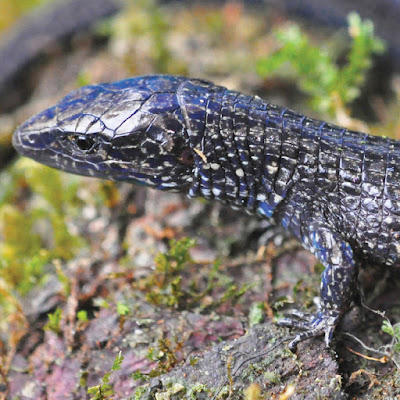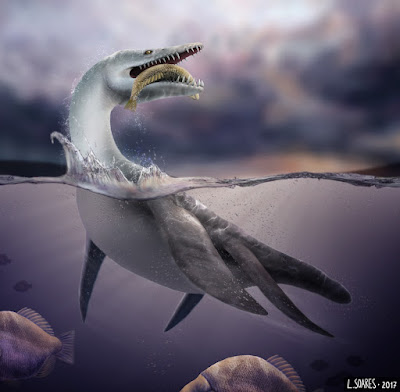[Most Recent Entries] [Calendar View]
Friday, August 18th, 2017
| Time | Event | ||||||
| 6:03a | [Herpetology • 2017] Oreosaurus serranus • Formal Recognition of the Species of Oreosaurus (Squamata, Gymnophthalmidae) from the Sierra Nevada de Santa Marta, Colombia
Abstract Oreosaurus is one of the two genera extracted from the former Riama sensu lato, which was recently recognized as polyphyletic. Oreosaurus is a small clade (five named and two undescribed species) of montane gymnophthalmid lizards and exhibits an exceptional distributional pattern. Its nominal and undescribed species are discontinuously distributed on the Cordillera de la Costa of Venezuela, the tepuis from the Chimantá massif in Venezuela, the highlands of the island of Trinidad, and the Sierra Nevada de Santa Marta in Colombia (SNSM). Herein, we describe the species of Oreosaurus that is endemic to the SNSM. Historically, this species associates with two names that are currently nomina nuda: Proctoporus serranus and P. specularis. Formal nomenclatural recognition of Oreosaurus serranus sp. n. renders specularis a permanently unavailable name for this taxon. Oreosaurus serranus sp. n. is the sister of all remaining congeners, and differs primarily from them in having only one pair of genial scales, as well as a unique pattern of scutellation. We provide an identification key to the species of Oreosaurus. Keywords: Microteiid lizard, Oreosaurus serranus, nomenclatural recognition, Proctoporus serranus, Proctoporus specularis, nomina nuda, South America, taxonomy
Diagnosis: Oreosaurus serranus sp. n. can be distinguished from all its congeners by the number of genial pairs (1 in O. serranus sp. n. versus 2 in the other species). It also differs from all other species of Oreosaurus, except O. mcdiarmidi, by the number of supraoculars (3 in O. serranus sp. n. and O. mcdiarmidi versus 4 in the other species), and dorsal scale relief (smooth in O. serranus sp. n. and O. mcdiarmidi versus keeled or slightly keeled in the other species). Oreosaurus serranus sp. n. also differs from O. mcdiarmidi by the absence of prefrontal scales (present in O. mcdiarmidi). ..... Distribution and natural history: Oreosaurus serranus sp. n. is known exclusively from the type locality (Figs 4, 5) and San Lorenzo (Ayala and Castro unpublished data, Ayala 1986), two adjacent cloud forest localities on the northwestern slopes of the Sierra Nevada de Santa Marta (SNSM) at elevations of about 1800–2156 m (Fig. 4). This forest-dwelling lizard is often found under fallen, rotten trunks or logs. Holotype and paratypes were collected manually during the day. The new species was found at the type locality in sympatry with Anadia pulchella, another gymnophthalmid endemic to the SNSM. Etymology: The specific epithet serranus, which is an adjective derived from the Spanish adjective serrano (meaning from the sierra), refers to the location of the species’ type locality in the Sierra Nevada de Santa Marta, and preserves the original etymological intent of Harris, as stated by Ayala and Castro (unpublished data). Santiago J. Sánchez-Pacheco, Pedro M. Sales Nunes, Miguel T. Rodrigues and Robert W. Murphy. 2017. Formal Recognition of the Species of Oreosaurus (Reptilia, Squamata, Gymnophthalmidae) from the Sierra Nevada de Santa Marta, Colombia. ZooKeys. 691; 149-162. DOI: 10.3897/zookeys.691.13595 Resumen: Oreosaurus es uno de los dos géneros que fueron extraídos de Riama sensu lato, el cual fue reconocido recientemente como polifilético. Oreosaurus es un clado pequeño (cinco especies nominales y dos indescritas) de gimnoftálmidos de montaña y presenta un patrón de distribución excepcional. Sus especies nominales e indescritas se distribuyen discontinuamente sobre la Cordillera de la Costa de Venezuela, los tepuyes del macizo de Chimantá en Venezuela, las tierras altas de la isla de Trinidad, y la Sierra Nevada de Santa Marta en Colombia (SNSM). Describimos la especie de Oreosaurus que es endémica de la SNSM. Históricamente, esta especie se asocia con dos nombres que son nomina nuda: Proctoporus serranus y P. specularis. El reconocimiento formal de Oreosaurus serranus sp. n. hace que specularis sea un nombre permanentemente indisponible para este taxón. Oreosaurus serranus sp. n. es la especie hermana de todos los congéneres restantes, y se diferencia de ellos principalmente por tener un único par de escamas geneiales, así como por presentar un patrón único de escamación. Proveemos una clave de identificación para las especies de Oreosaurus. | ||||||
| 8:19a | [Paleontology • 2017] Thaumatodracon wiedenrothi • A Morphometrically and Stratigraphically Intermediate New Rhomaleosaurid Plesiosaurian from the Lower Jurassic (Sinemurian) of Lyme Regis, England
Abstract An excellently preserved partial skeleton of a rhomaleosaurid plesiosaurian (NLMH 106. 058) from the Sinemurian (Lower Jurassic) of Lyme Regis, England, is described. The material consists of a complete cranium, mandible, and articulated cervical vertebral column. It is noteworthy because large-headed rhomaleosaurids are rare from this stratigraphic horizon and it is taxonomically distinct. The material is referred to a new taxon, Thaumatodracon wiedenrothi gen. nov. et sp. nov, diagnosed by two autapomorphies: 1. a pronounced transverse trough on the posterior margin of the dorsal ramus of the squamosal; 2. possibly paired anteriorly tapering triangular basioccipital processes. It also possesses a unique combination of other characters including a ‘short’ premaxillary rostrum (length and width subequal), five premaxillary alveoli, premaxilla-maxilla sutures parallel anterior to the external nares, frontals contact on the midline, prefrontal-frontal suture convex and gently curved medially, mandibular symphyseal region spatulate and ‘short’ (length and width subequal), prominent dorsally concave medial flange anteromedial to the articular glenoid, robust rod-like axis neural spine with a circular transverse cross section, and cervical neural spines with a mediolaterally expanded apex. The taxon shares some of these characters with earlier Hettangian rhomaleosaurids (e. g. Atychodracon, Eurycleidus), and other characters with later Toarcian rhomaleosaurids (e. g. Rhomaleosaurus sensu stricto and Meyerasaurus). Inclusion of Thaumatodracon as an additional operational taxonomic unit in several existing cladistic analyses demonstrates that it occupies a relatively derived position within Rhomaleosauridae. A morphometric multivariate analysis of Lower Jurassic rhomaleosaurids shows that Thaumatodracon is also proportionally intermediate between known rhomaleosaurid taxa. Thaumatodracon is therefore a stratigraphically and anatomically intermediate taxon that fills a gap in our knowledge of the evolution of this macro-predatory plesiosaurian clade. Keywords: Plesiosauria, Sauropterygia, Rhomaleosauridae, Lower Jurassic, Lyme Regis
Adam S. Smith and Ricardo Araújo. 2017. Thaumatodracon wiedenrothi, A Morphometrically and Stratigraphically Intermediate New Rhomaleosaurid Plesiosaurian from the Lower Jurassic (Sinemurian) of Lyme Regis. Palaeontographica, Abt. A: Palaeozoology – Stratigraphy. 4-6; 89 - 125. DOI: 10.1127/pala/308/2017/89 Adam S. Smith and Ricardo Araújo. 2017. Morphometric data and phylogenetic analysis of Thaumatodracon wiedenrothi. PANGAEA. DOI: 10.1594/PANGAEA.870543 Português descreve nova espécie dos mais antigos dinossauros marinhos http://www.dn.pt/lusa/interior/portugues-d |
| << Previous Day |
2017/08/18 [Calendar] |
Next Day >> |








